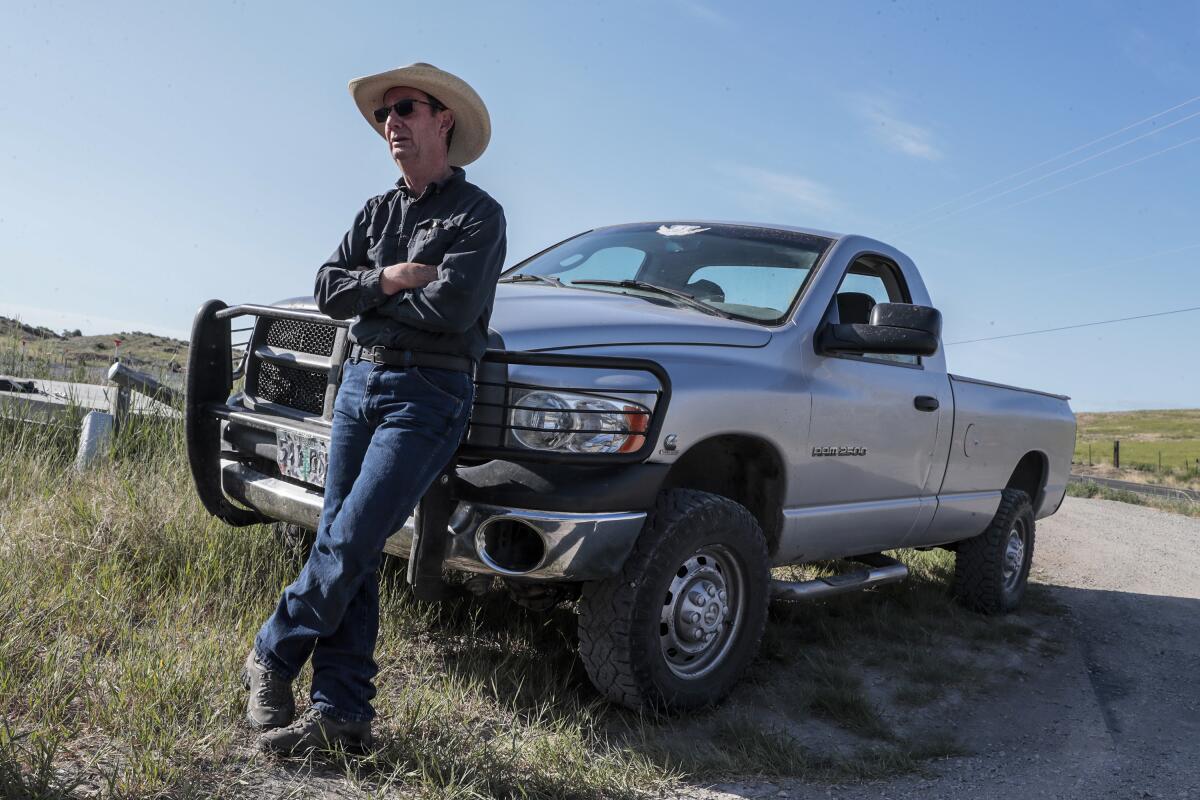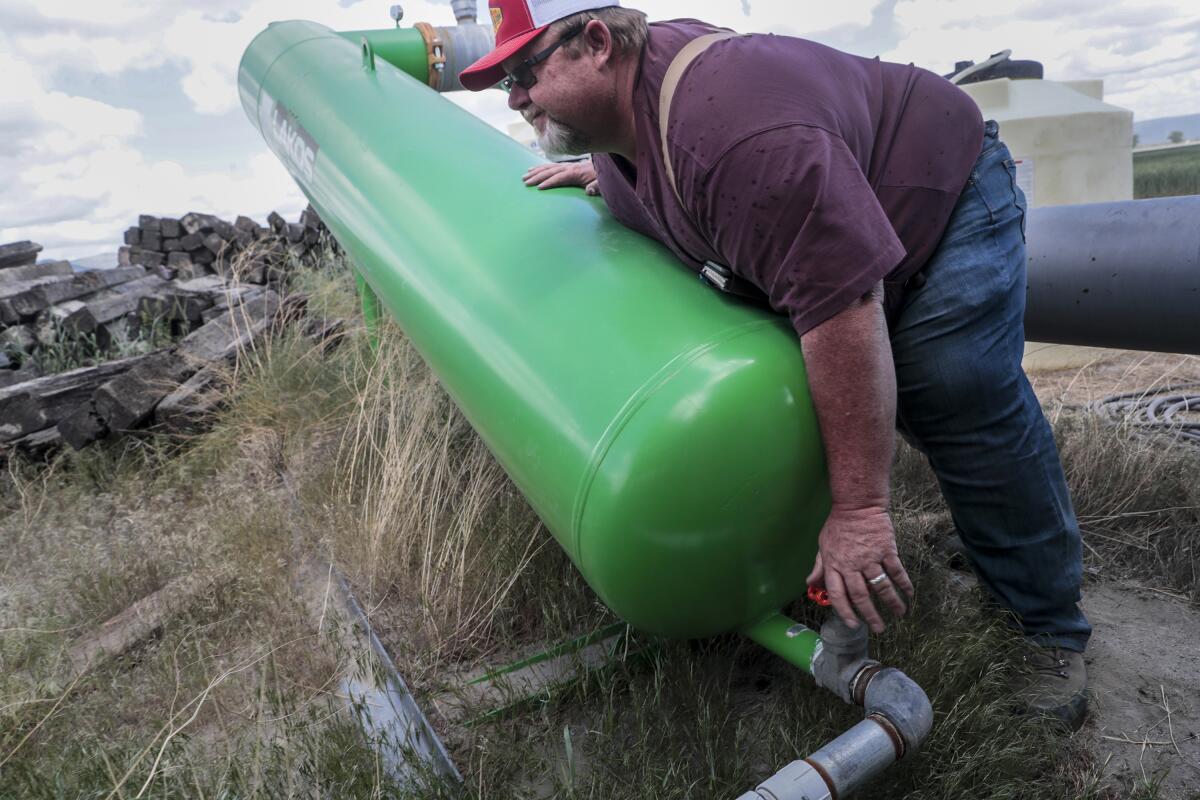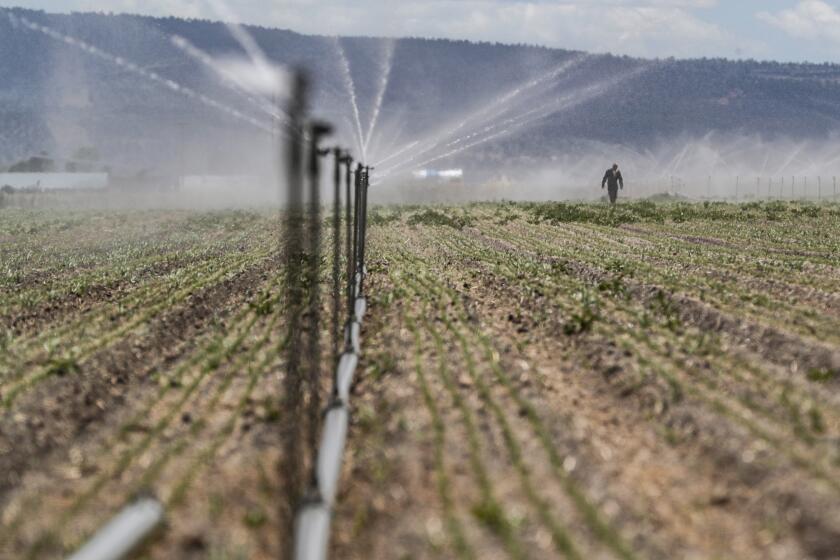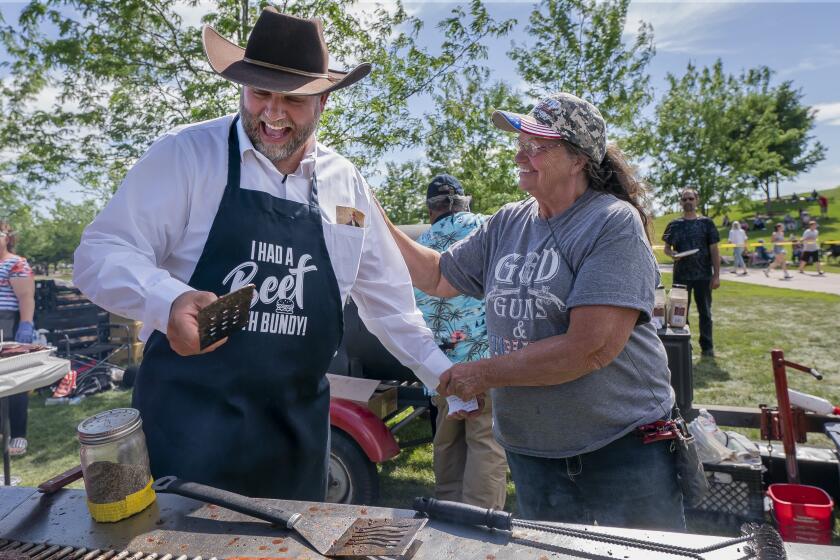As drought slams California and Oregon, Klamath farmers grow fish to quell a water war

- Share via
TULELAKE, Calif. — It’s a strange place to find fish, deep in the high desert, where drought-baked earth butts against scrubby mountains.
But water spews from the hot springs on Ron Barnes’ land near the California-Oregon border, pure and perfect for rearing c’waam and koptu, two kinds of endangered suckerfish sacred to Native American tribes.
Barnes, who holds an advanced degree in aquaculture from UC Davis, has dug dozens of ponds on his property and filled them with thousands of young suckerfish. He hopes raising and releasing them into the wild will end the region’s epic water wars — or at least get federal regulators out of the mix before his neighbors descend into violence.
“We have to take a pragmatic view of this thing,” said Barnes, standing near his black-bottomed lagoons under an intense morning sun. “The single most effective way to get the government off our backs is to restore the fish population.”
The suckerfish, which are on the endangered species list, are at the heart of a rancorous water controversy. They typically spawn in nearby Upper Klamath Lake, an agricultural reservoir that is growing increasingly dry and toxic. To ward off their extinction, federal regulators have cut off every drop that normally flows from the lake to the Klamath Reclamation Project, a federally built web of irrigation canals that once held the promise of almost limitless water for nearby farms.

Growers and landowners in the region are divided between those who are furious but want a peaceable path forward, like Barnes, and those who are threatening to take water by force.
Extremism — from white nationalism to anti-government militancy to secessionism — has long had a foothold here, and some are worried that, with no compromises in sight, their neighbors will push the situation to an armed confrontation with government authorities.
“We’re doing our damnedest to keep cooler heads here, to let cooler heads prevail,” said Scott Seus, a family farmer who relies on water from the lake. “There’s a sense of desperation right now, and not many people who want to listen.”
Federal scientists and wildlife officials have asserted that maintaining a healthy lake is critical for preventing extinction of the suckerfish, as the U.S. Endangered Species Act requires them to do. But families who have homesteaded here for generations say their problems stem not from the degraded lake or climate change — which many of them dismiss — but government ineptitude. They say federal regulators keep doing the same things year after year, benefiting neither fish nor farmers.
“I just wish we could look at it and say, ‘We’ve been doing this and we’re not getting any success, can we try it a little different?‘” said Paul Crawford, a local grower.
After farmers were told this year that they wouldn’t receive any water from the lake, a small contingent of landowners formed an alliance with People’s Rights, a group backed by militant anti-government activist Ammon Bundy.
That contingent has set up a red-and-white-striped circus tent on private property next to the federal irrigation gates in Klamath Falls, Ore., and is threatening to take over the plumbing works, releasing water in a symbolic act that has the potential to turn into an armed conflict.
There is a feeling inside the tent, and in the fields, that nobody at the federal level is listening to the concerns of farmers as their lives and legacies deteriorate.
“I lost my next generation on my ranch,” said farmer Tracey Liskey, whose only son left the farm after the last water shut-off. “They took the water away, and he said, ‘Dad, I’ve got to go find a job I can depend on.’”
His son moved to Boise and became a diesel mechanic.
Liskey, a friend of Barnes, who has excavated many of the ponds on his property, said he agrees with the people in the tent but thinks they have gone too far toward the “radical right.”
“When you start bringing Bundy in and that kind of stuff, you’ve lost what you’re protesting, because he isn’t us,” Liskey said. “We don’t want outsiders trying to come in and run their politics on our issues.”
::
Barnes’ and Liskey’s rearing ponds, part of a complex called Gone Fishing, where Barnes raised tropical aquarium fish until that market crashed in 2008, have been so successful that the U.S. Fish and Wildlife Service partnered with them in 2015 after an earlier pilot program. It has plans to expand the operation with the hopes of eventually releasing 60,000 c’waam and koptu into the lake each year at an age when they are old enough to survive the difficult conditions.
“I really don’t care about the sucker [fish] myself, but it has control of my water,” Liskey said.
Replenishing their numbers is “the only ray of hope,” he said.
Under the Trump administration, farm advocates made headway in revising federal policies, but they have little confidence that President Biden — who has pledged stricter enforcement of environmental regulation — will come to their aid. Supporters of Biden say the seriousness of drought presents few pathways for easy fixes.
“The reality is, throughout the West we have a climate crisis, and there is not enough water to go around, and business as usual will not work,” Sally Jewell, U.S. secretary of the Interior under Barack Obama from 2013 to 2017, told The Times.
Black Lives Matter has emboldened a younger generation of the Klamath Tribes, who are now speaking out on their treatment on the parched Oregon-California border.
The Klamath Tribes, who also have fish hatcheries of their own, say the c’waam and koptu are indicator species that show the entire Klamath Basin is in ecological jeopardy. Simply adding stock to Upper Klamath Lake, they say, doesn’t fix larger problems like pollution runoff from cattle grazing above the lake, or less water coming in from snowmelt that no longer flows reliably from the nearby mountains.
But Jewell understands that it is difficult for farmers to hear that the old ways of doing business may not work in the future, especially when the government hasn’t made an alternative clear.
“It’s hard to let go of the ‘from’ if you don’t know what the ‘to’ is,” she said.
She said she was concerned about involvement in the Klamath water crisis by the Bundy family, who, she said, “are people that are exploiting grievance” and “ramping up extremism.”
Bundy, who has said he supports the Klamath Basin farmers, has been involved in two armed standoffs over land rights issues with the federal government — both under Jewell’s tenure — one of which ended with a fellow militant being killed by authorities near the Malheur National Wildlife Refuge in Oregon.
Inside the tent, Bundy followers regularly preach of government overreach and corruption, depicting regulators and environmentalists as enemies who have stolen water that rightfully belongs to farmers.
Though the senior water rights in the lake are held by the Klamath Tribes, who consider the c’waam sacred, farmers have junior rights that they believe are being violated — though courts have not agreed.
A similar militant protest took place at the Klamath headgates during a 2001 drought, after federal officials cut off water. Several times that summer, protesters forced open gates that had prevented supplies from flowing from Upper Klamath Lake into irrigation canals.
Farmer Dan Nielsen, who pitched the circus tent this spring, set up camp near the same spot back then, with supporters who included Liskey. The camp drew hundreds of people, while federal law enforcement officers stood guard at the headgates.
Tim Evinger, the newly elected sheriff of Klamath County at the time, was suddenly thrust into the national spotlight as tensions between local protesters and federal agents mounted. He said the situation was “like navigating a minefield.”
“My constituents, in many cases, thought that the government was overreaching, and they felt like they were being wronged,” he told The Times.
Evinger said he faced enormous pressure from federal agencies to arrest the protesters for trespassing and vandalism. He declined. Like many in Klamath Falls, he viewed the protest as a 1st Amendment right, as long as there was no violence.
The protests then, as today, drew the attention of the far-right. According to the Southern Poverty Law Center, militia members decrying the “U.S. Gestapo” in emails volunteered to “fire the first shot at the feds.”
But Evinger said locals did a good job in preventing their cause from being hijacked by outsiders — something easier to do before social media.
“There were a few radical folks and hotheads that would show up and take the bullhorn or mic occasionally,” Evinger said. “And you just didn’t know what that was going to create.”
He said he would urge caution to the protesters today to not have their issue taken over.
Ammon Bundy built his name on confronting government. Now he wants to be Idaho’s governor, pledging to protect conservative values by turning federal land into private development.
This time, though, there are fewer farmers and more anti-government outsiders present.
“I’m not a believer that everything the federal government does is bad. They have a role. That’s why I stressed the separation of power,” he said.
After the terrorist attacks on Sept. 11 of that year, the protesters in Klamath Falls decided to pack up and leave.
The standoff helped push hard discussions around the Klamath Basin, which ultimately led to what many hoped was a historic, albeit complicated, compromise that involved years of negotiations and dozens of participants. Hammered out over countless meetings, it ultimately fell apart when Congress failed to fund it in 2015, largely because the local congressman backed out of supporting it at the last moment.
Goodwill evaporated. Litigation renewed. Many now wonder if any compromise is possible.
“The agreement really called on people’s better angels, and the dispute that is trying to be exploited right now calls on our dark sides,” said Jewell, who helped forge the later part of the Klamath agreement. She said she believes a compromise can be found, but it would require agricultural interests to acknowledge that the abundance of the past is gone.
“It’s a different time, and so I think many people who are inclined to protest are protesting something that is so changed fundamentally from what it was,” she said.

Mike McKoen, a third-generation farmer who, like Liskey and Barnes, is advocating for a compromise, said he fears a future in which the water remains cut off.
“When people start looking down the barrel of foreclosures, which is going to happen, when their livelihoods are drying up and going away, what choices do they have?” he said.
All around Barnes’ unlikely oasis, fields once lush with alfalfa, onions and mint are dusty and fallow. Irrigation canals are filled with weeds, except in places where ice-blue well water provides a shrinking lifeline for a lucky few.
Some farmers are so desperate that they are using tractor engines running 24 hours a day on diesel to pump that water uphill through jury-rigged pipes that groups of farmers have laid themselves, forming collectives of ingenuity and need. After the last shut-off, California funded the drilling of wells along the county line, but that groundwater can’t sustain agriculture indefinitely.
On a recent day, unexpected wind threatened to kill the onion sprouts in one of the only fields McKoen has been able to irrigate. He needs the crop to survive, since he has young twins to support and has already lost multiple fields of mint.
When the gusts blew up from the north, billowing dry dirt into clouds that battered the inch-tall stalks, it seemed like the stress might be McKoen’s undoing. He gunned his truck, bouncing it over the rutted lane that led to his sprinklers, where he flipped on a pump. The water lines came to life, spraying into the airborne dirt. McKoen did not know if it would be enough. The worry, he said, felt like it could kill him.
“They think that we are a bunch of rich farmers that don’t care about the environment, that don’t care about the tribes, that don’t care about the fish,” he said.
“But am I the guy that’s going to lose it? My generation is going to waste what those before me nearly killed themselves to build? That’s not a good feeling.”
Chabria reported from Tulelake, and Branson-Potts reported from Los Angeles.












